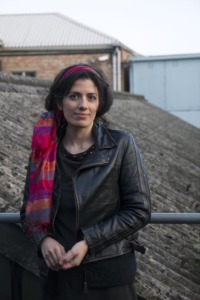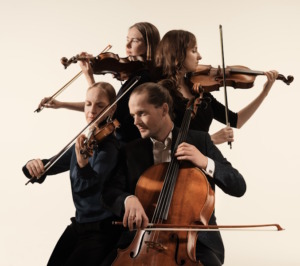
Bushra El-Turk
For a long time, my artistic pursuits have been concerned with the idea of ‘giving voice’- either by giving a platform to unheard voices from a community or by giving voice to the musicians of an ensemble by weaving in improvisation within notated works.
In the same vein, this set of pieces takes the form of three tributes to Levantine female singers who lived during the Nahda period, a cultural renaissance in the Arabic-speaking world that took place between the mid-19th century and the early 20th century. I think I’ve been spending half of my life trying to integrate Western and Eastern elements in my compositions. And, being a British-born Lebanese and back on a deep mission to understand my heritage, particularly after my father passed away, I was inspired by the music, concepts and stories that came out of the Nahda period. I have been listening and studying the stories behind some rare and less rare archival 78rpm recordings from collectors in the region and across the pond. I guess it is a form of hauntology, as coined by the French philosopher Jacques Derrida in his 1993 book, Spectres of Marx.
Not only am I giving voice to these fascinating figures of that time and place, but the ethos behind my writing for musicians is to write for the personalities behind the instruments, rather than purely for the instruments. With this I wanted to highlight the spirit and essence of the Dudok Quartet Amsterdam. I made it a priority to know them and get inside their artistic missions in order to get to the depths of what this piece should entail.

Dudok Quartet Amsterdam. Photo Green Room Creatives Yuri Andries
The great thing about the Dudoks is that they were so open to try new things and to experiment with me. We had a workshop in Amsterdam which included various improvisational games and I brought in Zakieh Agob’s recording for them to comment on it, getting their perspective on the music, which in turn fed into my compositional process and the piece itself. The composition ranges from notation to improvisation in a way that is embedded inside the score, so that my material is always recreated in an instant every time it is performed, bringing the music to the present moment as it converses with the ghosts of the past – either with a recording from 1908 recording or fragments of musical material that these singers would have sung based on Andalusian song forms like the muwasshah or folk songs from the Levant.
Portrait I (Zakieh Agob) – 5’- is dedicated to the elusive Lebanese-American, Zakieh Agob (born 1886 or 1888) who came under many names, so uncovering information on her has been challenging. She represented a ghostly figure to me under these different identities, even while she was alive. She is important because she was one of, or perhaps the first Arab-American singer(s) to record for Columbia records, and as a young mother worked as a part-time dress maker and being widowed just after her seventh child was born. She represents someone who managed to do so much with so little and against all odds. The piece takes the essential fragments of a dawr, which is a genre of Arabic vocal music normally sung in colloquial Arabic, and is titled ‘Lama kawani al hob ya nass’ trans. ‘When love burned my heart.’
Click here for the link of the track that inspired this piece.
Portrait II (Haseeba Mowshe) – 5’ – is dedicated to Haseeba Mowsheh, a Beiruty singer who rose to fame. If played with the recording, it is a Syrian folk song called ’Under Her Howdah, woe is me’ (recorded in 1908) and the humming is the fragmented melody shadowing it.
Here is the music that accompanies the piece:
Portrait III (Rasmiya Jumaa) – 5’ – is dedicated to Rasmiya Jumaa who was blind. She played the oud and only attended women’s concerts due to her religion. This piece is a re-imagining of the muwasshah (a traditional Arabic form of music and poetry) ’Ya Ghosn al Naqa’ by an anonymous composer based on text by Abu Bakr Ibn Zahr Al-Andalousi (1094-1162). There are no records of her singing in the archive, but the muwasshah is one of the classics I assume she may have sung.
Listen to the music that inspired this piece:
The Dudok Quartet Amsterdam gives the UK premiere of Three Tributes on 17 October at Milton Court Concert Hall, London. The evening programme includes the Dudok arrangements of works by Geusaldo and Schubert’s Death and The Maiden quartet.
This article was originally published in The Strad and is here reused with permission
